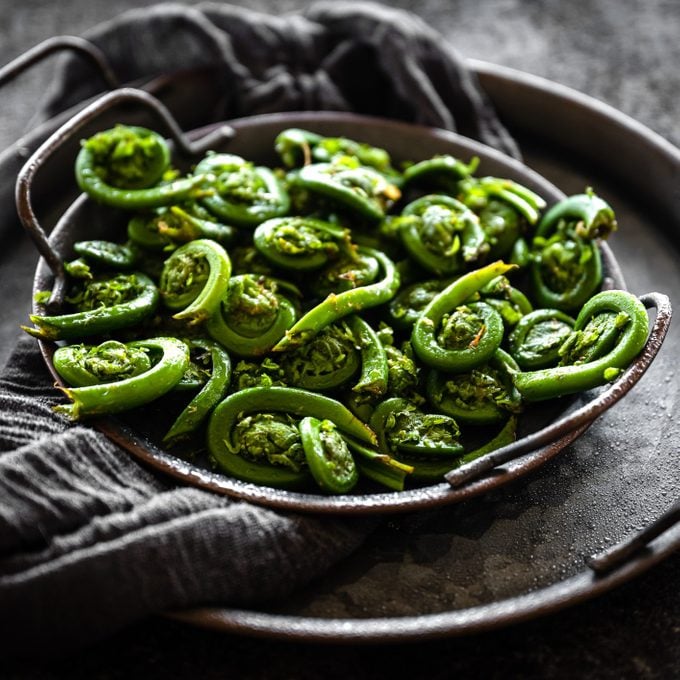Once you've tasted a fiddlehead fern, you'll want to add it to all your favorite springtime dishes.

What Are Fiddlehead Ferns?

Anyone following a seasonal diet keeps a close eye on the first signs of spring. After a long winter of nothing but leafy greens and root vegetables, you’ll be more than ready for some variety! One of the tell-tale signs of seasonal change is the emergence of perennial vegetables, like asparagus, rhubarb and the fiddlehead fern.
These wild-grown coils are a favorite among foraging enthusiasts because they’re only available for a very brief season. The plant is no longer edible once the sprouts open up and become feathery leaves, so you’ll want to snatch them up as soon as you see them at the market.
They taste fantastic no matter how you serve them: on a salad, baked into quiche, sauteed in butter, tossed with pasta, added to pizza or tempura battered and deep-fried.
What Is a Fiddlehead Fern?
Fiddlehead ferns are named after the scroll on a violin or fiddle, and they’re the edible sprouts in the fern family.
In the spring, the fern plants unfurl and stretch toward the sky. They can be harvested during the brief period when they remain coiled in a spiral, measuring roughly one inch in diameter. Once cooked, fiddlehead ferns have a tender-crisp texture and taste sweet and grassy with earthy and nutty undertones. Most people describe the flavor and texture as a mixture between asparagus, green beans, spinach and broccoli stems.
Are Fiddlehead Ferns Safe to Eat?
While almost all fern plants produce fiddleheads, not all fiddleheads are edible. Most fiddlehead ferns contain toxins that can cause symptoms like dizziness, abdominal cramps, headache, diarrhea or nausea. Even the edible ones need to be cooked fully to avoid foodborne illness.
Ostrich ferns are generally accepted as the safest edible fiddlehead. Lady ferns are also considered edible, though some advise that this variety should only be eaten in small quantities since they do contain mild toxins.
The University of Maine advises against eating bracken ferns, as they have been shown to cause cancer in rats under laboratory conditions.
Where to Find Fiddlehead Ferns
Fiddlehead ferns are not a cultivated plant, so you won’t find them at your local farm. (Although, growing ostrich ferns in your flowerbed is a fantastic edible landscaping idea.) Instead, they grow wild in the shade of the forest floor. They can be found in damp climates, like river valleys or dense forested grounds.
Their season depends largely on the location and the weather, but they’re generally available between late April and early June.
How to Harvest Fiddlehead Ferns
The best way to find fiddlehead ferns is to locate mature ostrich ferns, which have bright green fronds that fan out and resemble ostrich feathers. The fiddleheads sprout close to the mature plants in small clusters. From there, consult a harvesting book to make sure you understand what to look for when foraging this wild-grown delicacy.
Ostrich fiddlehead ferns have a deep grove shaped like the letter “U” on the smooth stem and the coiled head will also have a brown, papery covering. If the fiddlehead’s stem is fuzzy and does not have these identifying marks, it may be a fern that is not safe to eat.
Fiddlehead ferns are ready to harvest when the frond remains tightly curled and stands about two to six inches from the forest floor. Use a knife to separate the fiddlehead from its stem, or gently snap it off with your fingers. Look for crowns with multiple fiddleheads and leave at least half of the sprouts on the crown, creating sustainable growth that allows you to come back year after year.
How to Cook Fiddlehead Ferns

Prepare the fiddleheads by removing the papery skin and rinsing them clean from any soil. You may need to soak them in cold water for a few minutes to help release any caked-on dirt or grime. Store the cleaned fiddleheads in a plastic bag in the refrigerator for up to a week. If a long stem is attached to the coiled head, clip it off close to the coil just before cooking and discard the stem.
From there, you’ll want to blanch the fiddleheads to ensure they’re fully cooked before consuming. Raw or undercooked fiddlehead ferns can lead to foodborne illness. Bring a pot of salted water to a boil and add the cleaned fiddlehead ferns. Cook for 10 to 15 minutes, until the fiddleheads are tender, and transfer them to an ice bath to halt the cooking.
Blanched fiddleheads can be enjoyed chilled on salads, but you can also saute them in butter or roast them in a high-temperature oven to give them a crisp texture. They’re delightful when paired with any spring recipe. If you have more than you can enjoy in one week, preserve your blanched fiddlehead ferns by pickling them in your favorite pickling brine or by freezing them in freezer-safe bags for up to a year.
